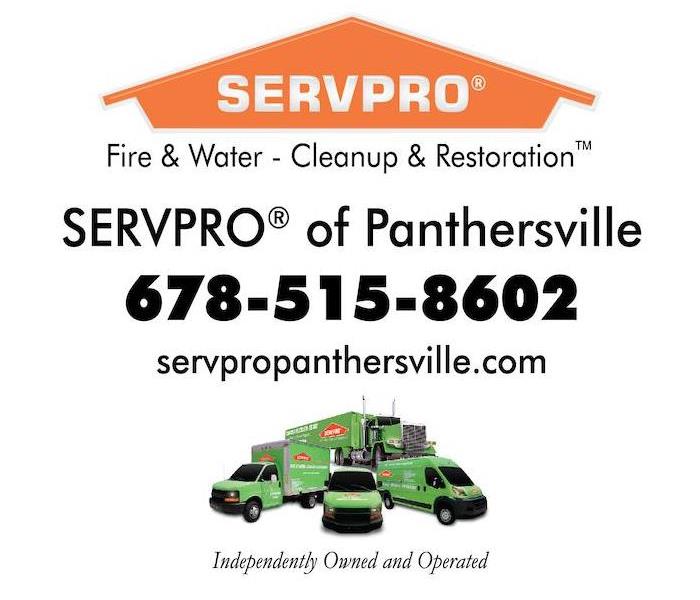Recent Posts
Treating Mold
11/1/2023 (Permalink)
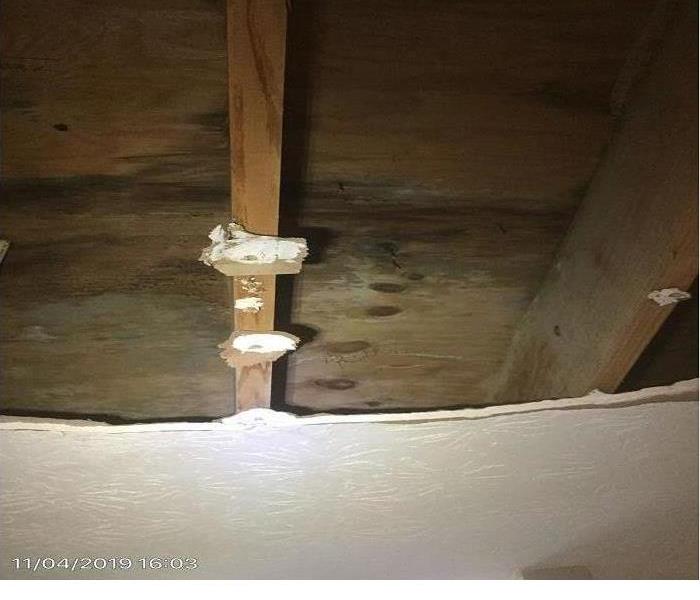 Treating Mold
Treating Mold
More often, mold can be self-treated. Nevertheless, it takes more than just a simple wipe-down with a wet cloth. This might effectively remove some of the unsightly black marks, but it does nothing to clear away the spores. You will find that over a few days or weeks, the mold will grow back in the same place. You may have even exacerbated the issue by wetting the walls. This perceived stubbornness could be the reason why so many homeowners are terrified by the appearance of mold. They may think that because it grows back, then it is indicative of a deeper issue with the house. However, the likely issue is that the mold is just not being treated as aggressively as it should. A mix of detergent or bleach as home remedy must be used to eradicate the spores, and ventilation needs to be improved to prevent the issue from recurring. The ways you can treat and prevent mold growth include:
- Using a fan to improve circulation
- Replacing air filters
- Keep walls and soft furnishings dry
- Use a dehumidifier to keep the house's humidity below 60%
- Wipe away condensation from walls and windows
- Insulate cold surfaces
?If mold problem exists in a home that you intend to buy is significant, then you would be best advised to hire SERVPRO® of Panthersville professionals to clean away the mold. The Environmental Protection Agency recommends leaving cleanups to the professionals when the mold growth exceeds 10 square feet.
There are visible signs of mold on the ceiling joists.
Don’t hesitate to contact SERVPRO® of Panthersville at 678-515-8602 for your Mold Remediation services.
Water Damage Hazards!
11/1/2023 (Permalink)
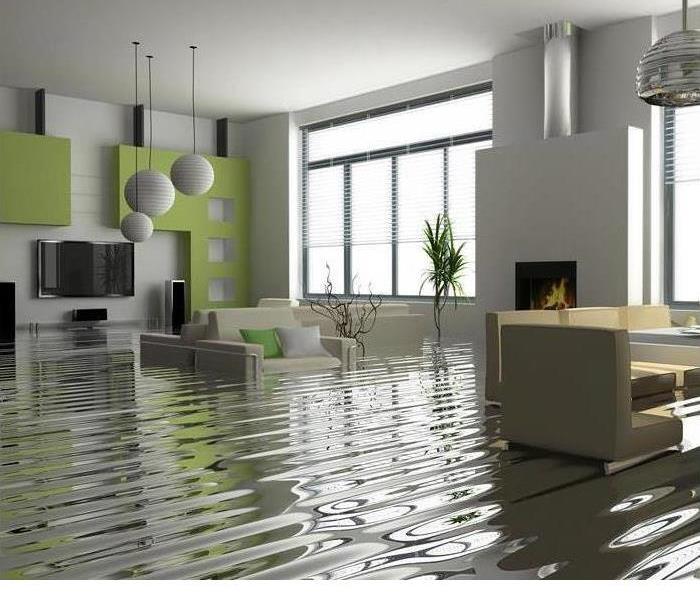 flood hazards cause furniture and area to overflow with water.
flood hazards cause furniture and area to overflow with water.
The safety hazards and precautions associated with water damage restoration are as follows:
Electrical Hazards
Mixing water and electricity creates a potential for disaster, and electrical hazards exists everywhere on the typical water damage job site. Water that comes into the building from either a roof leak or from water pipes in the attic is likely to intrude into the wiring system. Floods may also cause water to intervene into the wiring system.
The first item to check is the power distribution box. Turning off all circuit breakers at the power distribution panel is the easiest way to protect you, your Crews, and building occupants from electrical shock hazards. If only a portion of the building is affected, then turn off all circuits that provides power to the damaged areas if water has intruded into wall cavities and electrical outlets, or when electrical outlets are located on the floor. Use either a lockout device or tagout device when circuits are turned off to prevent shock hazards.
Structural Hazards
Storm damaged structures might be weakened and pose hazards. Floods and earthquakes can cause considerable damage to a building foundation or to the bearing partitions under and around a structure. Storm surge and wave action from a hurricane can undermine foundations or damage pilings in pier-type construction. Long-term exposure to water may destroy the structural reliability of materials, such as particle board and drywall, which creates a hazard for workers and occupants. Determine the potential structural hazards before proceeding with mitigation and restoration services.
Hazardous Materials
Hazardous chemicals or hazardous materials, lead, and asbestos may be present in some water damaged buildings. Be alert for hazardous materials and do not try to handle or remove them unless you are certified to handle hazardous materials. Use qualified Subcontractors to remove and dispose of hazardous materials.
Slip, Trip, and Fall Hazards
Water damaged structures and the restoration processes can create numerous slip, trip, and fall hazards. Wet surfaces are usually slick, equipment hoses, and power cords provide ample opportunity for workers and occupants to slip, trip, or fall. Post warning signs and brief occupants about the hazards. Slippery floors are a common hazard in water damaged situations. People may not recognize the potential hazard of walking from a wet carpeted surface onto a hard floor surface, such as vinyl tile. Wet shoes may not slip much on the carpet, but when the person steps onto the hard floor surface then a serious slip hazard exists. Ensure that occupants understand this hazard.
Hoses and power cords may become a tangled maze for occupants and workers to navigate during emergency services. During the drying stage, equipment power cords may be a problem for occupants. Secure dehumidifier and air mover cords to limit the hazard during the drying phase. Floating carpets also present a trip hazard. Ensure occupants understand that they should not be walking on carpet that is being floated.
The living room consists of contemporary furniture and this area is affected by approximately 4 feet of standing water.
Do not hesitate to contact SERVPRO® of Panthersville at (678) 515-8602 when disaster strikes from water damages!
Fire Safety Equipment
11/1/2023 (Permalink)
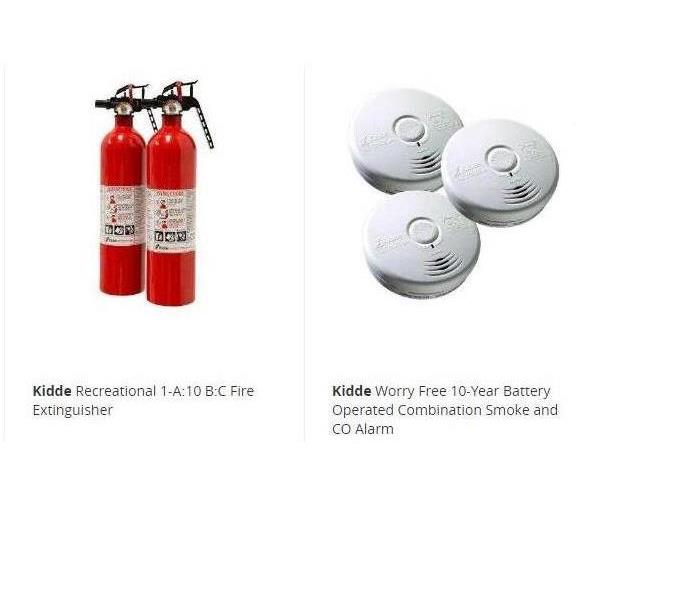 Use these fire safety tools to protect your home, family, and pets from fire, smoke, and poisonous carbon monoxide gas
Use these fire safety tools to protect your home, family, and pets from fire, smoke, and poisonous carbon monoxide gas
Fires can start in a variety of ways, which includes faulty electrical wiring, lightning strikes, cigarette smoking, cooking mishaps, dryer vent ignition, gas furnace ignition, fireplace ignition, portable heater tip-overs, and so forth. Fires can smolder for hours before suddenly erupting into flame. If you have an electrical fire, a fire extinguisher, sand, and baking soda can be used once the electrical source of the fire has been disrupted.
Fire Extinguishers
Fire extinguishers are classified by ratings of A, B, and C. These ratings determine the size and type of fire that the extinguisher can put out as follows:
- A type fires—they consist of burning wood, paper, and fabric.
- B type fires—they consist of flammable liquids, such as gasoline and oil.
- C type fires—they are electrical.
The number that precedes the letter determines how big of a fire the extinguisher can put out in increments of 2.5 feet. For example:
- A 10-B:C extinguisher—it can put out a 25-square foot fire from a flammable liquid or electrical source.
- A 5-B:C extinguisher—it can handle a 12.5-foot fire from a flammable liquid or electrical source.
Smoke Alarms
There are two basic types of smoke detectors as follows:
- Ionization smoke alarms—they are better at detecting small particles that are produced in greater amounts in flaming fires, which quickly consume combustible materials and spread in many directions.
- Photoelectric smoke alarms—they are better at detecting large particles that are produced in greater amounts in smoldering fires, which may smolder for hours before bursting into flame.
Both types are effective in detecting smoke and fire, but the best smoke alarms feature both technologies.
Carbon Monoxide Detectors
Carbon Monoxide (CO) is a toxic, colorless, odorless, poisonous gas that comes from an appliance malfunction and burning fossil fuels, such as oil, gas, and coal. A furnace crack, dryer vent clog, and a blocked chimney can all produce CO. Use carbon monoxide alarms to detect a leak quickly.
Under normal operation, a carbon monoxide detector is able to vent the small amounts of CO gas that is produced outside of your home. However, small amounts of CO gas can build up and become a life-threatening problem when the vents are blocked.
Carbon monoxide deprives you of oxygen that your blood depends on to sustain life. If you are exposed to even small amounts of CO, then it quickly bonds with hemoglobin in your blood and displaces oxygen. When this occurs, you experience flu-like symptoms, such as headaches, fatigue, nausea, dizzy spells, confusion, and irritability. As more time passes, the symptoms can worsen to include vomiting, loss of consciousness, brain damage, and even death. Place a CO detector in every bedroom, living room, and basement in your home to prevent carbon monoxide poisoning.
There are two fire extinguishers and three 10-year battery smoke alarms.
Use these fire safety tools to protect your home, family, and pets from fire, smoke, and poisonous carbon monoxide gas.
Choose a Professional Company to Clean your Ducts
11/1/2023 (Permalink)
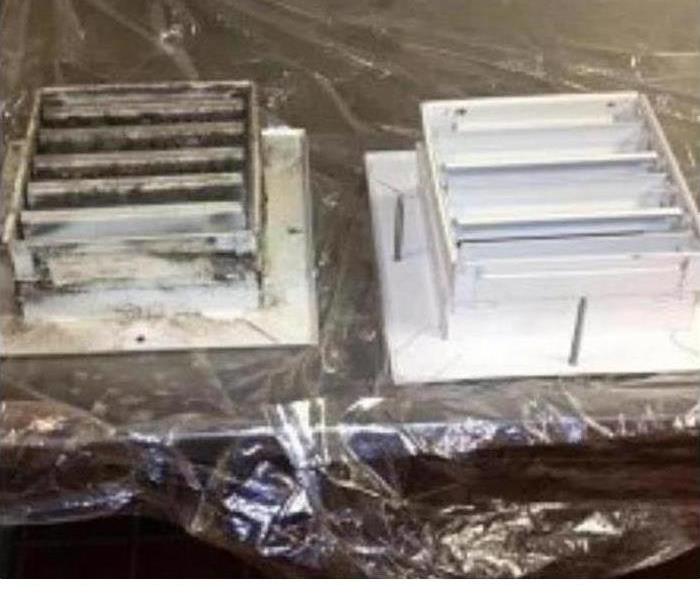 Do not skip your ducts tune-up. Contact SERVPRO® of Panthersville at (678) 515-8602.
Do not skip your ducts tune-up. Contact SERVPRO® of Panthersville at (678) 515-8602.
Choose a Professional Company to Clean your Ducts
Are the ducts that send warm (or cool) air into your home causing breathing problems for your family? The interest in air duct cleaning has grown in recent years, particularly as homeowners become more concerned about their indoor air quality or look for better ways to improve energy use.
According to the EPA, there are several important health reasons you should consider having your ducts cleaned as follows:
- Is substantial mold growth visible inside the ducts or other components of your heating and cooling system? If mold is present, then duct cleaning is not the only step to take. You would also want to correct whatever conditions that cause the growth of the mold. Additionally, if air duct insulation gets wet or has mold, then you will need to have it removed and replaced instead of cleaned.
- Are your ducts clogged with excessive amounts of dust and debris and other particles, and are these substances being released into your home from your supply registers? This affects your indoor air quality as poor-quality air continues to be pumped back into your home.
- Are your ducts infested with rodents or insects or other unwelcome critters? There are some reasons why you would want the ducts cleaned.
Duct cleaning is an as-needed service that supports routine maintenance on your system. Fuel-burning furnaces should be serviced and inspected annually to protect against carbon monoxide poisoning and to improve efficiency.
There are two ducts wherein the one on the left is dirty and needs to be cleaned while the one on the right is cleaned.
Do not skip your ducts tune-up. Contact SERVPRO® of Panthersville at (678) 515-8602.
Does Your Home or Business have Mold Problems?
11/1/2023 (Permalink)
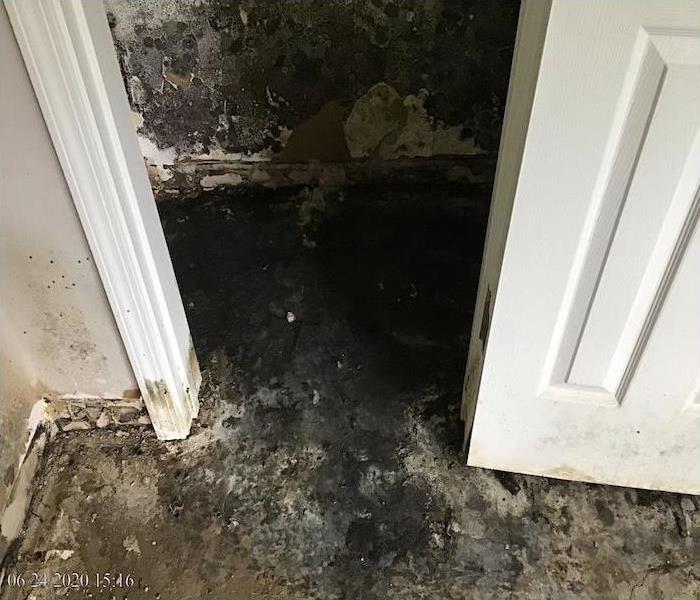 Mold can spread through your home or business within 48 hours. Call SERVPRO® of Panthersville today at (678) 515-8602 if you see visible signs of mold
Mold can spread through your home or business within 48 hours. Call SERVPRO® of Panthersville today at (678) 515-8602 if you see visible signs of mold
Microscopic mold spores naturally occur almost everywhere, namely, both indoors and outdoors. This makes it impossible to remove all mold from a home or business. Therefore, mold remediation service reduces mold spores count back to its natural or baseline level. Some restoration businesses advertise “mold removal” and even guarantee to remove all mold, which is a fallacy.
Consider the following mold facts:
- Mold is present almost everywhere, which is, indoors and outdoors.
- Mold spores are microscopic and float along in the air and may enter your home or business through windows, doors, AC/heating systems, or even hitch a ride indoors on your clothing or a pet.
- Mold spores thrive on moisture, and they can quickly grow into colonies when exposed to water. These colonies may produce allergens and irritants.
- Before mold remediation begins, all sources of water or moisture must be addressed. Otherwise, the mold may return.
- Mold often produces a strong, musty odor, and it can lead you to possible mold problem areas.
- Mold can cause severe health effects and significantly damages your property.
If your home or business has mold problems, then we can inspect and assess your property and use our specialized training, equipment, and expertise to remediate your mold infestations.
Important Candle Safety Information
7/8/2022 (Permalink)
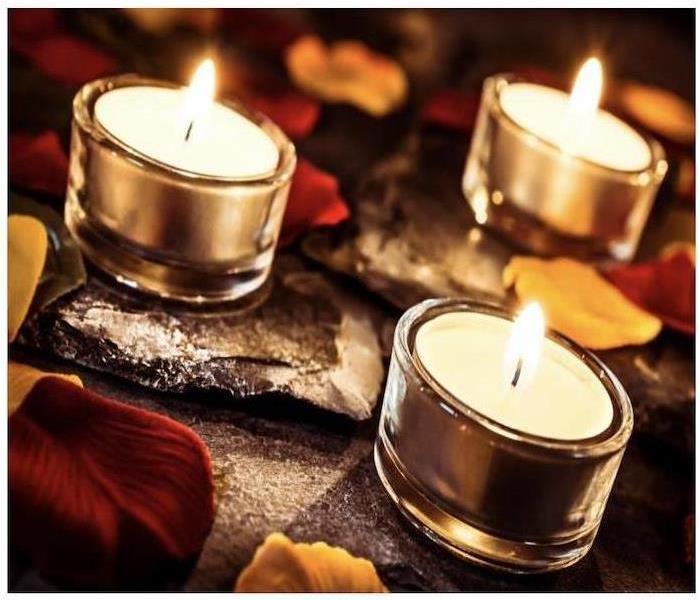 Prevent fire hazards from candles but contact SERVPRO® of Panthersville at (678) 515-8602 if your property has fire damages.
Prevent fire hazards from candles but contact SERVPRO® of Panthersville at (678) 515-8602 if your property has fire damages.
Fire Hazard can Occur from a Candle and so Tips to Prevent Fire and Serious Injury
- Before you light a candle ensure that you do as follows:
- Always trim wick to ¼ inch before lighting—dispose of wick trimmings and matches to keep debris out of wax pool.
- Avoid drafts
- Set candle on heat-resistant surface
- While the candle is lit ensure that you do as follows:
- Burn within sight—always remain within line of sight of burning candles. Extinguish candles before leaving room. Never burn for longer than four-hour intervals.
- Keep away from things that catch fire—never burn candles on or near anything that can catch a fire.
- Keep away from children and pets—children and pets could accidentally tip candle over.
- After use of the candle ensure that you do as follows:
- Do not extinguish with water.
- Always allow wax to harden before relighting, touching, or moving.
Charitable Donations
7/8/2022 (Permalink)
At SERVPRO® of Panthersville, our commitment to the community though our charitable donations is as important as providing emergency cleaning and restoration services for twenty four hours a day. We want to be judged not only by the service we provide, but also for what we do to improve the quality of life for all people in the places where we live, work, and nationwide.
Our charitable donations include organizations that benefit Veterans, African Americans, Firefighters, and individuals who suffer from Autism, Alzheimer's, and Breast Cancer illnesses. The company's Management Team also participates in local walks in honor of Autism, Alzheimer's, and Breast Cancer patients, and we volunteer service with the American Red Cross for their Home Fire Campaign by installing smoke detectors in people's homes.
Ways to Add a Pop of Color without Painting
7/1/2022 (Permalink)
 These are great suggestions if you are thinking about selling your home and want to create a beautifully staged canvas for potential buyers.
These are great suggestions if you are thinking about selling your home and want to create a beautifully staged canvas for potential buyers.
Repainting a room or your entire house is a great way to bring a brand-new look to your home. But it can also be messy and time-consuming to do yourself and expensive if you hire professionals. Also, if you do not like the results, then you have to restart from scratch. Fortunately, there are other ways to add an exciting splash of color to your residence.
Review the following ways to add a pop of color without using one drop of paint. More importantly, you can make these changes for just a fraction of the cost of a professional paint job, and you can change your mind as often as you would like:
- Wall Decorations—just because you are not painting your walls does not mean that they have to be bland. You can add a lot of color by using wall decorations. Find a large, colorful wall painting that takes up a lot of room on an empty wall. Hang a wall tapestry, or even invest in temporary wallpaper to create an accent wall. These alternatives not only add color and pop to your décor but also create an intriguing focal point for the room.
- Furniture Accents—if you are not keen on buying brightly colored furniture, then use furniture accents to add color to your décor. Use a mix of soft tones and vibrant colors to create a unique look. There are a number of accents to mix and match such as afghans, throw pillows, and blankets. Actually, many professionals recommend mixing and matching patterns and colors to create a vibrant color scheme. What is the best part? You can change these furniture accents as the seasons change without the hassle of painting.
- Table Accents—used in combination with furniture accents and wall decorations, table accents and other inspiration pieces can help to create flow. Picture how all the colors will work together. Look for accents such as vases, picture frames, and other trinkets that will add a pop of color without the commitment.
- Floor Decorations—there is little risk and a lot of reward by using floor decorations to add color to your home interiors. If you have a neutral colored couch, adding a bright area rug can play off of your neutral furniture beautifully. Use multiple rugs in addition to the area rug to really jazz up the space and add dimension.
- Window Decorations—your window treatments have a huge impact on the way that your rooms feel. Whether it is how much (or how little) light gets in or how big or small your windows are, getting creative with your window decorations is an excellent way to add color and texture to your home.
- Colorful Furniture—maybe you don't want a bright red couch in your living room, but have you thought about a bright red armchair? Using strategically placed colorful furniture pieces will liven up any room. Even if the rest of your furniture is neutral, these colorful pieces will improve the overall aesthetic of the room. You can achieve this same look with textured and patterned pieces.
- Plants and Flowers—often overlooked inside of the home are fresh plants and flowers that add dimension and liveliness throughout your space. A simple vase of fresh flowers on the kitchen counter or a potted palm in the corner of the living room can make a huge impact on the diversity of color in your home.
These are just a few of the many ways to add pops of colors to your home. What are some of the ways you have avoided painting in the past?
Fire or Smoke Damage Tips
7/1/2022 (Permalink)
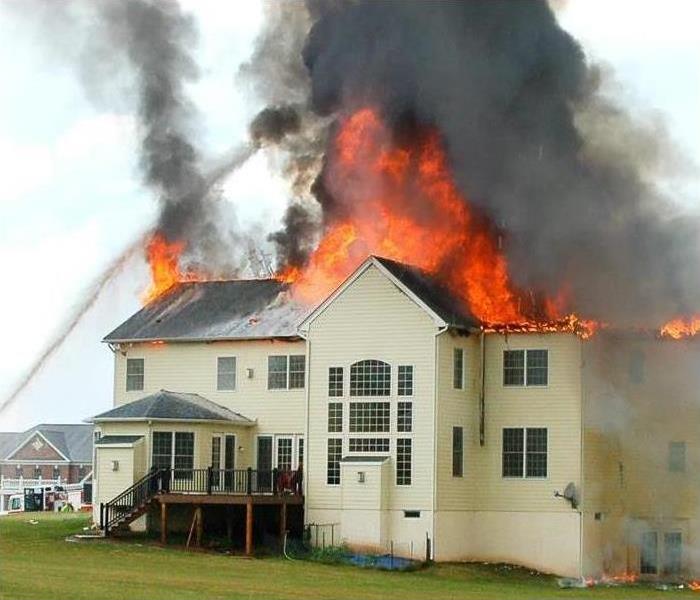 Do not hesitate to contact SERVPRO® of Panthersville at (678) 515-8602 if you encounter fire or smoke damages!
Do not hesitate to contact SERVPRO® of Panthersville at (678) 515-8602 if you encounter fire or smoke damages!
Severe fire damages can be the most devastating thing to happen to any property when disaster strikes. Consequently, you have most likely lost some personal belongings and areas of your home are destroyed. The following tips can assist you when notifying your insurance company about a fire loss claim:
Check Your Policy
Although you have replacement coverage for your home, you may only have "actual cash value" for the personal items that were lost. Therefore, ensure that your agent notifies you about this and suggests that you buy an endorsement so that your belongings will be covered under a replacement policy.
Secure Your Property
Most homeowners' coverage policies require you to take reasonable steps to minimize more harm on your property, which is essentially your duty to mitigate damages. These steps are relatively easy to do, such as either covering leaking areas with plastic wrap or turning off the water if you discover a huge pipe burst. Your insurance company will more often pay these costs when you make your claim.
File Your Claim Immediately
All homeowners’ policies require you to report your losses promptly. You are required to call your agent and submit a Proof of Loss claim in which you should itemize your losses in detail and list the values of each item.
Always Keep Track of Your Living Expenses
All homeowners’ policies include a Loss of Use clause, which entitles you to adequate reimbursement for living expenses while you are out of your home. Subsequently, these expenses only include additional living expenses, which means the difference between what it costs you to live daily and what it is costing you thereafter. For instance, if you ate most of your meals at home and your groceries cost you $400 a week, and after a fire you are eating out and spending $500 a week, then you can only claim that additional $100.
How to Prepare for Winter Storms
7/1/2022 (Permalink)
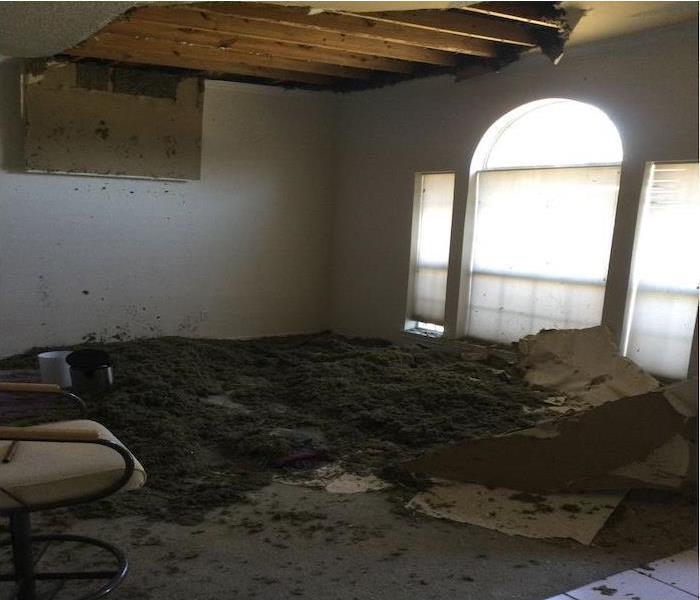 Do not hesitate to contact SERVPRO® of Panthersville at (678) 515-8602 when disaster strikes from winter storms!
Do not hesitate to contact SERVPRO® of Panthersville at (678) 515-8602 when disaster strikes from winter storms!
Take the time to prepare a winter survival kit for your home
The winter kits should include several days of non-perishable items, such as bread, crackers, cereal, canned foods, and dried fruits. An emergency supplies list should include an alternate way to stay warm during a power failure, such as kerosene for a kerosene heater or extra blankets, sleeping bags, and warm winter coats.
Ensure that you have matches, a first aid kit with instruction manual, candles, flashlight or battery-powered lantern, battery-powered radio, battery-powered clock or watch, extra batteries, non-electric can opener, snow shovel, rock salt, any special needs items (diapers, hearing aid batteries, medications, and so forth)
Prepare your home for the coming storm
If you plan to use a fireplace or wood stove for emergency heating, ensure that your chimney or flue has been inspected. Ensure that there is a working smoke detector and a battery-operated carbon monoxide detector near the area to be heated.
Make sure to have a communication checklist
Listen to emergency broadcasts and weather forecasts. Get your phone batteries charged, and all devices that you may use.
Make a family communication plan. Your family may not be together during a winter event, so it is important to know how you will contact one another, how you will get back together, and what you will do during an emergency.
Look over your car and emergency checklist
Get gas in your car ahead of the storm. Check your antifreeze, oil, and wiper fluid.







 24/7 Emergency Service
24/7 Emergency Service






